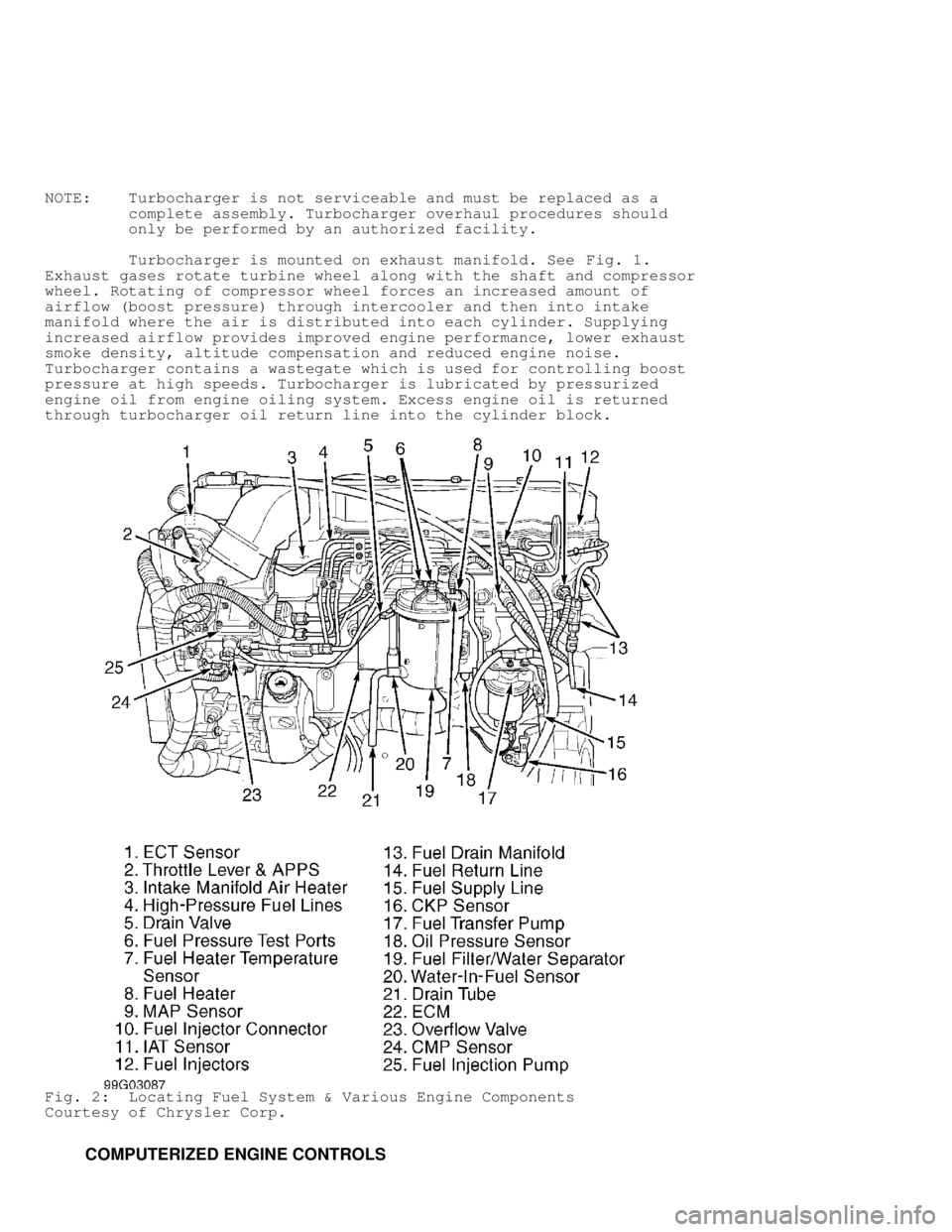Page 1399 of 1691
Anti-lock Brake Circuits
ANTI-THEFT
Page 1433 of 1691
Power Distribution Circuit (3 of 3)
POWER DOOR LOCKS
Page 1434 of 1691
Power Door Lock Circuit, W/ Keyless Entry
Page 1435 of 1691
Power Door Lock Circuit, W/O Keyless Entry
POWER MIRRORS
Page 1453 of 1691

* Air in fuel system:
* Coolant leak into combustion chamber:
* Block heater malfunction in cold weather:
* Clogged or defective fuel filter:
* Poor fuel quality:
* Fuel injector malfunctioning or loose:
* Restricted or blocked fuel injection or supply lines:
* Intake/exhaust valves not adjusted properly (tight):
* Intake heaters malfunctioning:
* Internal engine damage.
BLUE EXHAUST SMOKE
* Air filter dirty or plugged:
* Air intake system restricted:
* Air leak in intake between turbocharger and intake
manifold:
* Restricted exhaust:
* Restricted turbocharger drain tube:
* Crankcase ventilation plugged:
* Valve stems, guides or seals worn or defective:
* Piston rings improperly gapped, worn or broken:
* Internal engine wear:
* Turbocharger failure.
INTERMITTENTS
INTERMITTENT PROBLEM DIAGNOSIS
Intermittent fault testing requires duplicating circuit or
component failure to identify problem. These procedures may lead to
PCM setting a Diagnostic Trouble Code (FTC) which may help in
diagnosis.
If problem vehicle does not produce DTCs, monitor voltage or
resistance values using a Digital Volt-Ohmmeter (DVOM) while
attempting to reproduce conditions causing intermittent fault. A
status change on DVOM indicates a fault has been located.
Use a DVOM to pinpoint faults. When monitoring voltage,
ensure ignition switch is in ON position or engine is running. Ensure
ignition switch is in OFF position or negative battery cable is
disconnected when monitoring circuit resistance. Status changes on
DVOM during test procedures indicate area of fault.
TEST PROCEDURES
Intermittent Simulation
To reproduce conditions creating an intermittent fault, use
following methods:
* Lightly vibrate component
* Heat component
* Wiggle or bend wiring harness
* Spray component with water
* Remove/apply vacuum source
Monitor circuit/component voltage or resistance while
simulating intermittent. If engine is running, monitor for diagnostic
trouble codes. Use test results to identify a faulty component or
circuit.
Page 1460 of 1691

NOTE: Turbocharger is not serviceable and must be replaced as a
complete assembly. Turbocharger overhaul procedures should
only be performed by an authorized facility.
Turbocharger is mounted on exhaust manifold. See Fig. 1.
Exhaust gases rotate turbine wheel along with the shaft and compressor
wheel. Rotating of compressor wheel forces an increased amount of
airflow (boost pressure) through intercooler and then into intake
manifold where the air is distributed into each cylinder. Supplying
increased airflow provides improved engine performance, lower exhaust
smoke density, altitude compensation and reduced engine noise.
Turbocharger contains a wastegate which is used for controlling boost
pressure at high speeds. Turbocharger is lubricated by pressurized
engine oil from engine oiling system. Excess engine oil is returned
through turbocharger oil return line into the cylinder block.
Fig. 2: Locating Fuel System & Various Engine Components
Courtesy of Chrysler Corp.
COMPUTERIZED ENGINE CONTROLS
Page 1462 of 1691

* Charging System
* Cruise Control System
* Intake Manifold Air Heater
* Tachometer
* Torque Convertor Clutch Engagement (A/T Only)
* Transmission Overdrive Solenoid (A/T Only) Components are
grouped into 2 categories. The first category covers INPUT
DEVICES, which control or produce voltage signals monitored
by the PCM. The second category covers OUTPUT SIGNALS, which
are components controlled by the PCM. See PCM INPUT SIGNALS
and ECM/PCM OUTPUT SIGNALS.
ECM INPUT SIGNALS
Accelerator Pedal Position Sensor (APPS)
APPS sensor is mounted on top left of engine. See Fig. 2.
Sensor provides DC voltage input signal to Engine Control Module (ECM)\
to indicate throttle position. On previous engines, there were
linkages between accelerator pedal, throttle position sensor and
injection pump. On this engine, no linkage exists between accelerator
pedal and injection pump. ECM uses input signals from APPS sensor to
determine proper fuel delivery. ECM also outputs this signal to PCM.
Battery Voltage
Battery voltage input signal provides operating voltage to
Engine Control Module (ECM). This input signal keeps ECM memory alive
and informs ECM what generator output voltage is when engine is
running. ECM memory is used to store Diagnostic Trouble Codes (DTCs),
store APPS sensor voltages from previous key cycles and provide a
speed control adaptive memory.
Camshaft Position Sensor (CMP)
Camshaft Position (CMP) sensor is a hall effect sensor (0-5
volts switched), located below injection pump in rear face of timing
gear cover. Sensor is not used for fuel control. Sensor is used only
for diagnostic purposes.
CCD Bus Circuits
These circuits are connected between Engine Control Module
(ECM) and Powertrain Control Module (PCM) to allow communication
between modules.
Crankshaft Position Sensor (CKP)
Crankshaft Position (CKP) sensor delivers input signal (35
tooth wheel with gap) to Engine Control Module (ECM) to indicate
engine speed and crankshaft position. ECM uses CKP signal along with
other input signals for controlling injector firing sequence and
timing. Sensor is located below fuel transfer pump, on side of engine
block. See Fig. 2.
Data Link Connector (DLC)
Data Link Connector (DLC) provides an input signal to Engine
Control Module (ECM) when using scan tool to retrieve Diagnostic
Trouble Codes (DTCs) from ECM. Input signal may also be used when
performing various tests on the ECM and electronic control system.
Data link connector is a 16-pin connector located at lower edge of
driver's side of instrument panel, just above accelerator pedal.
Engine Coolant Temperature (ECT) Sensor
Engine coolant temperature sensor delivers input signal to
Engine Control Module (ECM) to indicate engine coolant temperature.
ECM uses input signal for controlling fuel control and timing. Engine
coolant temperature sensor is located on front of head, near
Page 1464 of 1691

manifold, sends input signal to Engine Control Module (ECM). ECM uses
input signal for controlling fuel control, timing and engine
protection. ECM will lower engine power if boost is too high.
Oil Pressure Sensor
Oil pressure sensor signal is input to Engine Control Module
(ECM). ECM converts signal to pressure value. Value is sent on CCD Bus\
to instrument panel gauge/light. Oil pressure sensor is located on
side of engine block, below ECM. See Fig. 2.
Power Take Off (PTO)
This input is used on vehicles equipped with a Power Take Off
(PTO) unit. When PTO is engaged, Engine Control Module (ECM) will
disable some OBD-II functions.
Water-In-Fuel (WIF) Sensor
WIF sensor is located in bottom of fuel filter/water
separator. See Fig. 2. WIF sensor delivers input signal to Engine
Control Module (ECM) when water exists in the fuel filter/water
separator. As water level increases, resistance across WIF sensor
decreases. ECM compares decrease in resistance to a high water
standard value. When resistance is 30,000-40,000 ohms, ECM will turn
on WATER-IN-FUEL warning light. WATER-IN-FUEL warning light is located
on instrument panel, just below tachometer. ECM monitors input signal
when ignition switch is in the ON position and continues to monitor
input signal until intake manifold air heater post-heat cycle is
complete.
PCM INPUT SIGNALS
A/C Switch
When A/C switch is in ON position, an input signal is
delivered from A/C switch to Engine Control Module (ECM) to indicate
that A/C operation has been requested. Once A/C operation has been
requested, an A/C request signal is delivered to ECM from A/C high-
pressure switch and A/C low-pressure switch. The A/C request signal
indicates evaporator pressure is within proper range for A/C
operation. ECM uses A/C request signal to cycle A/C compressor clutch
by using an A/C clutch relay. A/C clutch relay may also be referred to
as A/C compressor clutch relay. If A/C high-pressure switch or A/C
low-pressure switch opens, A/C request signal will not be delivered to
the ECM. ECM will then open ground circuit for A/C clutch relay and
A/C compressor clutch will be disengaged.
The A/C clutch relay is located in power distribution center
at driver's side front corner of engine compartment, near the battery.
The A/C high-pressure switch is located on discharge line, near A/C
compressor. The A/C low-pressure switch is located on top of
accumulator.
Accelerator Pedal Position Sensor (APPS) Output From ECM
Accelerator Pedal Position Sensor (APPS) is mounted on top
left of engine. See Fig. 2. Sensor provides DC voltage input signal to
Engine Control Module (ECM) to indicate throttle position. On previous\
engines, there were linkages between accelerator pedal, throttle
position sensor and injection pump. On this engine, no linkage exists
between accelerator pedal and injection pump. APPS signal is sent on
CCD Bus circuit from ECM to PCM.
Automatic Shutdown (ASD) Relay
A 12-volt input signal is delivered from ASD relay to Engine
Control Module (ECM) when ASD relay is energized. If ECM does not
receive a 12-volt input signal when ASD relay is energized, a
Diagnostic Trouble Code (FTC) will be stored in ECM. ASD relay is